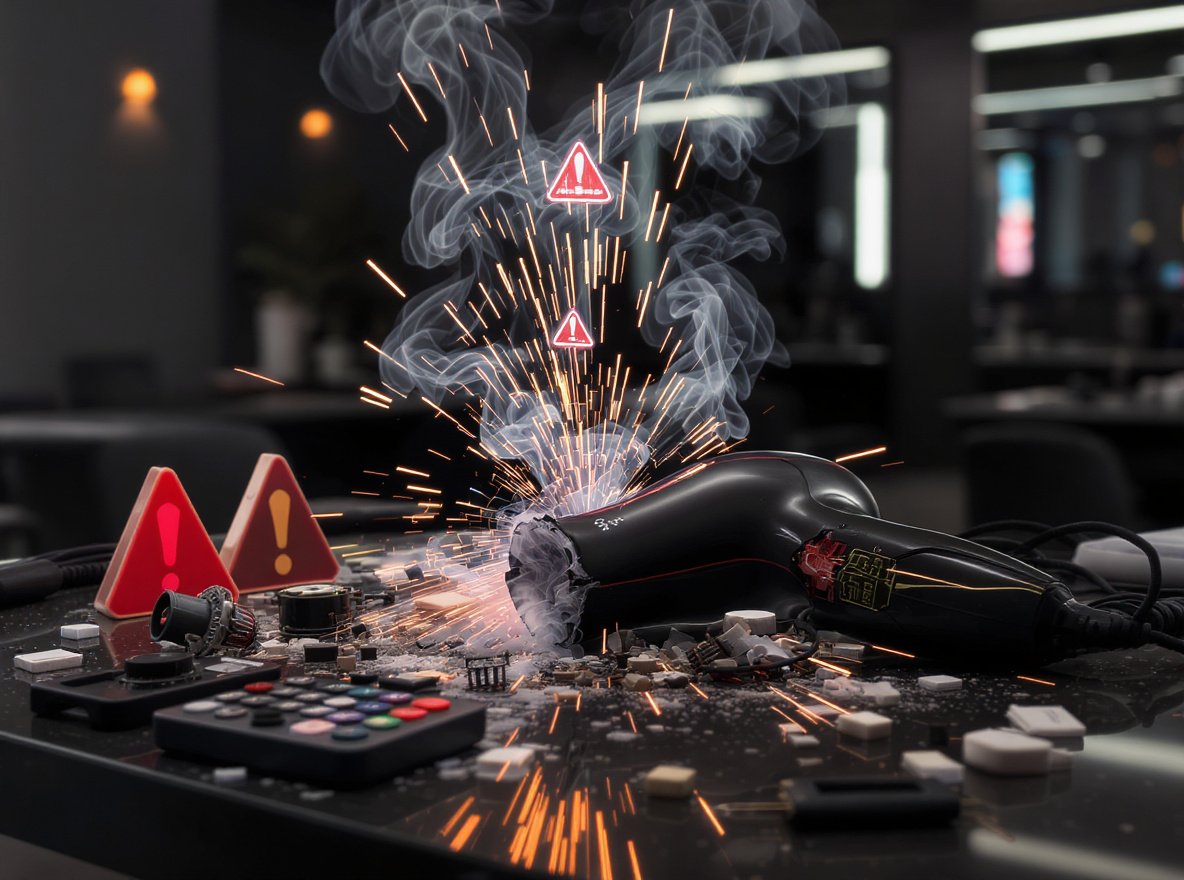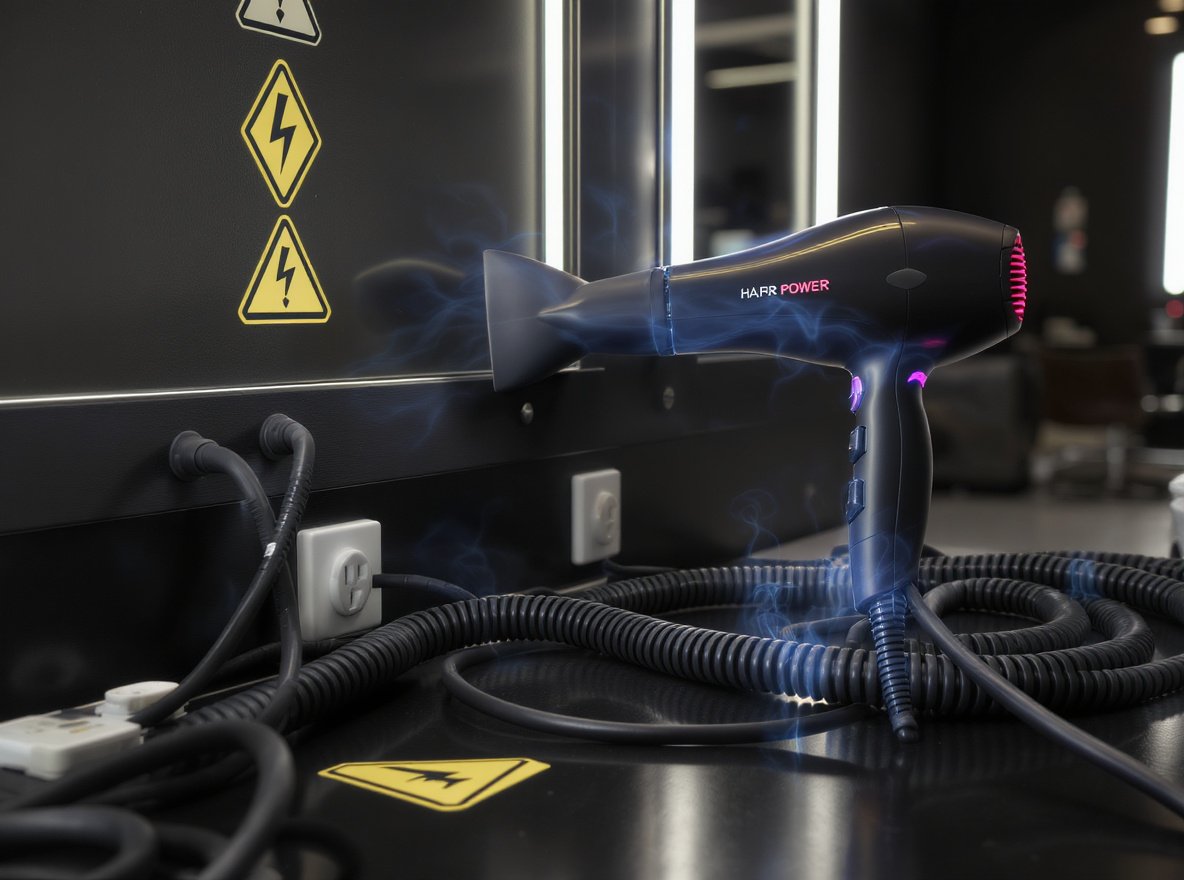Choosing the right hair dryer technology for your retail inventory can make or break your customers’ satisfaction. Both ionic generators and ion-infused ceramic coatings promise frizz-free results, but these technologies work through fundamentally different mechanisms that affect performance, pricing, and customer appeal.
An ionic generator uses high-voltage electric fields through charged needles to actively produce millions of negative ions per cubic centimeter, while ion-infused ceramic coating naturally releases ions when heated through minerals integrated into ceramic heating elements. Ionic generators offer precise control with independent operation, whereas ceramic coatings provide gentler, heat-activated ion production.
Understanding these differences helps you stock the right products for different market segments and customer needs.
Table of Contents
ToggleWhat Is an Ionic Generator in Hair Dryers?
Professional stylists and salon owners frequently ask about ionic generator technology because it represents the most advanced approach to ion production. This knowledge helps you position premium products effectively.
An ionic generator is a dedicated electronic component featuring high-voltage charged needles that actively electrolyze water molecules in the air, creating millions of negatively charged oxygen ions (O⁻) per cubic centimeter during operation.

How Ionic Generators Function
Ionic generators operate as separate systems within hair dryers, independent of heating elements. The technology uses high-voltage electric fields to break down water molecules continuously.
Key operational characteristics include:
• High-voltage charged needle system creates intense electric fields
• Active electrolysis process breaks down water molecules in real-time
• Independent control systems with dedicated on/off switches
• Consistent ion output producing millions of ions throughout drying
| Component | Function | Performance Benefit |
|---|---|---|
| Charged Needles | High-voltage ion generation | Millions of ions per cubic cm |
| Control Switch | Independent activation | Customizable ion output |
| Electric Field | Water molecule breakdown | Faster drying capability |
The generator creates negatively charged oxygen ions that are carried in the airflow and blown directly onto hair. This active production method allows precise control over ion intensity, making it ideal for customers who need maximum frizz control and faster drying times.
What Is Ion-Infused Ceramic Coating?
Many wholesalers wonder how ceramic coating technology compares to dedicated ionic generators. This passive approach offers unique advantages that appeal to different customer segments.
Ion-infused ceramic coating incorporates ionic materials directly into ceramic heating elements, creating natural ion emission when heated while simultaneously generating far infrared heat that penetrates the hair shaft.

How Ceramic Ion Technology Works
Unlike active ionic generators, ceramic coatings use clay-based materials treated with ionic minerals during manufacturing. The process creates dual benefits of heat distribution and ion production.
The ceramic coating system involves:
• Mineral-infused ceramic elements release ions naturally through heating
• Far infrared heat generation penetrates hair from inside out
• Even temperature distribution eliminates hot spots and damage
• Heat-activated ion release tied directly to operating temperature
Manufacturing integrates ionic minerals into ceramic clay materials during production, creating heating elements that emit both infrared heat and negative ions. This combination preserves natural moisture while providing gentle frizz control.
For customers with fine, damaged, or chemically treated hair, ceramic coatings offer protected styling without aggressive ion bombardment.
How Do These Technologies Differ in Ion Production Methods?
Retailers need to understand the fundamental production differences to explain benefits to their customers. These mechanisms create distinct performance characteristics that justify different price points.
Ionic generators produce ions through active electrical generation using high-voltage fields with precise control, while ion-infused ceramic coatings generate ions through passive heating of mineral-treated materials.

Production Method Analysis
The core difference lies in activation and intensity control:
Ionic Generator Characteristics:
- High-voltage electric field activation creates instant ion production
- Generates millions of ions per cubic centimeter consistently
- Independent operation allows activation/deactivation regardless of heat
- Precise control over ion concentration levels
Ceramic Coating Features:
- Heat activation gradually increases ion output as temperature rises
- Lower but steady ion production through mineral release
- Ion generation directly tied to heating element operation
- Natural integration of heat distribution and ion emission
| Factor | Ionic Generator | Ion-Infused Ceramic |
|---|---|---|
| Activation Method | High-voltage electric field | Heat-activated minerals |
| Ion Concentration | Millions per cubic cm | Moderate steady output |
| Control Precision | Independent on/off switch | Temperature dependent |
| Production Speed | Instant upon activation | Gradual buildup with heat |
Ionic generators excel at breaking down large water droplets into smaller particles with greater surface area, enabling drying times reduced by 30-50% compared to conventional dryers. This efficiency appeals to time-conscious customers willing to pay premium prices.
Which Technology Provides Superior Hair Protection?
Professional stylists prioritize hair health alongside styling results. Both technologies offer protection, but through different mechanisms that serve various hair conditions and customer needs.
Ionic generators provide protection through faster drying times reducing heat exposure by up to 50%, while ceramic coatings offer protection via even heat distribution eliminating hot spots and gentle far infrared penetration.

Protection Mechanism Comparison
Each technology protects hair through distinct approaches:
Ionic Generator Protection Benefits:
- Dramatically reduced drying time minimizes overall heat exposure
- Efficient water molecule breakdown enables lower temperature settings
- Enhanced moisture sealing through cuticle smoothing
- Superior static neutralization prevents friction damage
Ceramic Coating Protection Advantages:
- Consistent temperature control eliminates damaging hot spots
- Far infrared heat penetrates gently without surface overheating
- Natural moisture preservation through controlled heating
- Even heat distribution prevents localized thermal damage
For thick, coarse, or frizzy hair requiring intensive treatment, ionic generators provide the power needed while reducing exposure time. For fine, damaged, or color-treated hair needing gentle care, ceramic coatings offer protected styling without aggressive processing.
Many premium models combine both technologies, utilizing ceramic heating elements for gentle distribution alongside ionic generators for enhanced performance and frizz control.
What Are the Performance Differences Across Hair Types?
Your retail customers serve diverse hair types, making it crucial to understand which technology performs best for specific characteristics. This knowledge helps you recommend appropriate inventory for different market segments.
Fine hair benefits from ceramic coatings’ gentler approach, while thick or frizzy hair responds better to ionic generators’ intense negative ion output and faster drying capabilities.

Hair Type Performance Analysis
Different hair characteristics respond optimally to specific technologies:
Fine or Thin Hair Requirements:
- Excessive ionic output can make fine hair appear limp or flat
- Benefits from ceramic’s even heat distribution preventing damage
- Needs gentle treatment to avoid over-processing
- Responds well to moderate ion levels with consistent temperature
Thick, Coarse, or Frizzy Hair Needs:
- Requires intense negative ion output for effective static neutralization
- Benefits from fast drying to prevent prolonged heat exposure
- Needs powerful water molecule breakdown for efficiency
- Responds to high ion concentration for frizz control
| Hair Type | Recommended Technology | Primary Benefits | Market Appeal |
|---|---|---|---|
| Fine/Thin | Ion-infused Ceramic | Gentle heat, moderate ions | Broad consumer market |
| Thick/Coarse | Ionic Generator | Fast drying, frizz control | Professional/premium |
| Damaged/Treated | Ceramic Coating | Protected heating, moisture retention | Health-conscious consumers |
| Curly/Wavy | Ionic Generator | Pattern preservation, humidity resistance | Specialty styling market |
Ionic generators maintain curl definition while reducing frizz through enhanced moisture sealing, making them particularly valuable for customers with naturally textured hair who struggle with humidity and static.
Can You Successfully Combine Both Technologies?
Modern hair dryer manufacturing increasingly features hybrid systems, and your retail partners often ask about combination benefits. Understanding integrated technology helps you position premium products effectively.
Combination models featuring both ceramic heating elements and ionic generators offer comprehensive solutions, providing ceramic’s gentle heat distribution alongside ionic generators’ powerful frizz control and faster drying.
Hybrid Technology Advantages
Combining both systems creates synergistic benefits:
• Dual ion sources provide ceramic’s steady output plus generator’s intense concentration
• Optimized heat distribution through ceramic elements with enhanced ion benefits
• Versatile performance addressing diverse hair types with single products
• Professional-grade results matching salon-quality styling capabilities
Popular examples include models featuring ceramic heating coils with separate ionic generators, and premium units incorporating tourmaline-infused ceramic alongside dedicated ionic technology for enhanced ion production.
These combination units typically offer ionic on/off switches, allowing users to control ion output based on specific styling needs. This flexibility appeals to customers serving multiple family members or professional stylists working with various clients.
The Conason P1C exemplifies this hybrid approach, integrating both technologies seamlessly for maximum versatility and performance across all hair types.
Which Technology Offers Better Value for Wholesale Customers?
Investment decisions matter when building inventory that maximizes profitability while serving customer needs. Understanding the value proposition of each technology guides better purchasing strategies.
Ionic generator models command higher retail prices due to advanced components but offer superior performance justifying premium positioning, while ceramic models provide cost-effective manufacturing with broad market appeal.
Wholesale Value Analysis
Consider these factors when selecting inventory:
Ionic Generator Investment Benefits:
- Higher retail price points from advanced technology positioning
- Appeals to performance-focused customers willing to pay premiums
- Strong marketing advantages with measurable benefits like 50% faster drying
- Suitable for professional salon markets and premium consumer segments
Ion-Infused Ceramic Advantages:
- More cost-effective manufacturing enables competitive retail pricing
- Broader market appeal across various hair types and budgets
- Lower maintenance requirements with fewer complex electronic components
- Excellent mid-market positioning with proven, reliable technology
| Factor | Ionic Generator | Ion-Infused Ceramic |
|---|---|---|
| Manufacturing Cost | Higher component complexity | Cost-effective production |
| Retail Price Point | Premium positioning | Mid-market accessibility |
| Target Customer | Performance-focused consumers | Broad general market |
| Profit Margins | Higher selling prices | Volume-based margins |
Combination models command the highest retail prices but offer comprehensive solutions that reduce inventory complexity while maximizing profit potential. They appeal to quality-conscious consumers seeking versatile tools that address multiple styling needs.
How Do These Technologies Impact Drying Speed Performance?
Drying efficiency directly correlates with customer satisfaction and energy costs, making speed a crucial selling point. Both technologies improve efficiency, but through different mechanisms with varying results.
Ionic generators reduce drying time by 30-50% through efficient water molecule breakdown, while ceramic coatings offer moderate speed improvements through even heat distribution and far infrared penetration.
Speed Performance Comparison
Time savings translate to customer convenience and operational efficiency:
Ionic Generator Speed Advantages:
- Breaks large water droplets into smaller particles with greater surface area
- Achieves drying times as fast as 5-15 minutes versus 20-40 minutes traditionally
- Enables effective drying at lower temperatures reducing overall exposure time
- Provides consistent fast performance regardless of hair thickness or length
Ceramic Coating Speed Benefits:
- Far infrared heat penetrates hair shaft for efficient inside-out drying
- Steady, consistent drying without hot spots or uneven results
- Speed gains from efficient heat transfer rather than aggressive breakdown
- Reliable performance with moderate but consistent improvements
The ionic generator technology delivers dramatic time savings that appeal to busy consumers, professional stylists, and salon environments where efficiency impacts profitability. Some models achieve professional-grade results in minutes rather than the extended sessions required by conventional dryers.
For customers prioritizing convenience and time savings, ionic generators provide compelling value propositions that justify premium pricing and professional positioning.
Summary
Ionic generators and ion-infused ceramic coatings serve different market needs through distinct technologies. Generators use high-voltage electric fields for active ion production with maximum frizz control and speed, while ceramic coatings provide gentle, heat-activated ion release with protected styling. Choose generators for premium positioning and performance-focused customers, ceramic for broad market appeal and cost-effective inventory.
Ready to enhance your product portfolio with advanced hair dryer technologies? Explore our complete collection featuring both ionic generator and ceramic coating options, including our flagship P1C hybrid model that combines both technologies. Contact us for wholesale pricing and technical specifications tailored to your market requirements.



